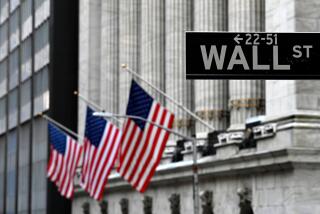Rating the Fund Raters: Who’s Better?
- Share via
Aside from the bottom line--i.e., performance--there are at least five things I’d want to know about a mutual fund before investing in it.
What does this fund promise to do? Has it kept its promise? Does it stack up well against its peers in terms of returns? Does it stack up well in terms of risk? And does it stack up well when it comes to fees?
Unfortunately, you’ll need to rely on a fund-tracking service or newsletter to easily answer some (probably most) of these questions.
In recent years, Morningstar Mutual Funds, published by Chicago fund tracker Morningstar Inc., has come to dominate this arena. Now New York-based Value Line, best known for its stock reports, is making a push with its Value Line Mutual Fund Survey. (The fund-tracking business was once solely controlled by Lipper Analytical Services, which serves mostly institutional clients.)
How do Morningstar and Value Line compare when it comes to evaluating mutual funds?
Both offer quick, one-page snapshots of thousands of mutual funds. But in general, the useful things you can find in Value Line’s reports you can find more of in Morningstar.
To be sure, Value Line has some bells and whistles. For instance, it will let you know how much you would have earned through a fund had you invested a lump sum versus small amounts each month (otherwise known as dollar-cost averaging). Morningstar’s reports will indicate only how much you would have earned through a lump sum.
But it’s unclear whether these bells and whistles are integral to making buy, sell and hold decisions.
Let’s compare the services based on how well they answer the questions above:
* What does the fund promise to do? Here, the edge goes to Morningstar.
Obviously, you can’t judge a fund without knowing what it’s likely to invest in. A fund that buys large growth stocks, for instance, promises to deliver much larger returns than one that invests in ultra-short-term bonds.
Morningstar separates its funds into 29 stock fund categories and 20 bond fund categories. Indeed, among U.S. diversified stock funds alone it has nine separate categories, based on the size of the companies the funds invest in (large, medium and small) and their investment styles (growth, value and a blend of the two).
For instance, Morningstar recently categorized Sound Shore as a “mid-cap value” fund. This means that the $1.6-billion fund tends to invest in medium-sized companies whose shares are thought to be undervalued relative to their peers, based on such variables as earnings or assets.
While Value Line categorizes its funds into similar “peer groups,” not all funds get this treatment.
In a recent report on Sound Shore, for instance, Value Line did not group the fund based on the size of stocks it invests in or its investment style.
* Has the fund kept its promise? No advantage here.
In addition to grouping its funds into specific categories, both Value Line and Morningstar indicate in easy-to-use charts the types of assets a fund invests in.
In a recent report on Sound Shore, for instance, Morningstar’s chart showed that this mid-cap fund was beginning to invest more like a large-cap value fund.
Morningstar also offers a recent list of each fund’s top holdings. And it provides key statistics on those holdings, such as price-to-earnings (P/E) ratios.
Value Line has a similar system.
* How do the fund’s returns stack up? Advantage: Morningstar.
Value Line tells you how well a fund has done each year (in terms of total returns) and then compares that to the performance of its average peer. In addition, it ranks each fund, based on risk-adjusted returns, on a 1-to-5 scale, with 1 being the best.
Morningstar does something similar but better. Like Value Line, it runs a 1-to-5 ranking system. It refers to this as its “star” system.
One difference: According to Morningstar, a five-star fund is considered the best and a one-star fund the worst. A more important difference: In handing out its stars, Morningstar compares its funds against one of four basic categories: domestic stocks, foreign stocks, taxable bonds and tax-free municipal bonds. Value Line compares its funds to one of only three large groups: stock funds, taxable bonds and muni bonds.
This makes Morningstar’s system more precise.
Also, Morningstar hands out an additional rating (also 1 through 5, with 5 being the best) for how well a fund is doing relative to its more specific category.
For instance, Sound Shore was given four stars when compared with all domestic stock funds. It was given a “category rating” of five when pitted against mid-cap value funds.
* How well does a fund stack up in terms of risk? Advantage: Morningstar.
Both rating services publish key statistics on funds’ volatility, such as beta and standard deviation. And both funds publish a proprietary risk-scoring system. Unfortunately, Value Line compares each fund’s risks compared with average peers in two large categories: stocks and bonds.
Morningstar, on the other hand, will indicate how risky a fund is relative to one of its four star-rating system groupings (domestic stocks, foreign stocks, taxable bonds and munis) as well as its specific category peers. That’s more precise.
* What about fees? Edge: Value Line.
Morningstar publishes in its reports all sales commissions, or loads, associated with a fund as well as the fund’s expense ratio. But it does not indicate how a fund’s expense ratio, which tells you what percentage of assets a fund skims off the top in the form of fees, stacks up against those of its peers.
Value Line, on the other hand, does.
*
Paul J. Lim covers the mutual fund industry for The Times. He can be reached at [email protected].
More to Read
Inside the business of entertainment
The Wide Shot brings you news, analysis and insights on everything from streaming wars to production — and what it all means for the future.
You may occasionally receive promotional content from the Los Angeles Times.









